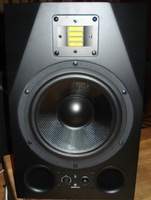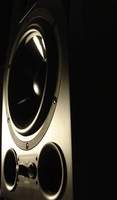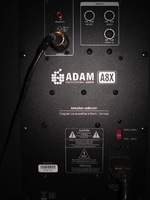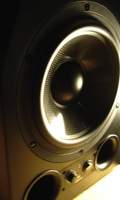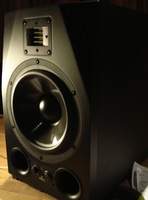It has become a yearly tradition for the German manufacturer ADAM AUDIO to launch a brand new product for the Musikmesse trade show in Frankfurt (Germany). Trade shows are meant for that, aren't they? This year was no exception for the trendy loudspeaker manufacturer. The proof is the new active studio monitor speaker A8X that complements the already comprehensive AX range.
A Brief Reminder
If case you don’t know (or you haven’t read our previous ADAM S3X-H Review), ADAM AUDIO has earned itself a solid reputation in the professional loudspeaker market over the years, thanks to its active studio monitors with ribbon tweeters. This technology — developed and patented by the German manufacturer under the name ART (Accelerating Ribbon Technology) — allowed for the development of several speaker ranges, including the famous “S Series” that became very successful very quickly.
In 2006, the manufacturer introduced a new series that included two compact and affordable active monitor speakers: the A5 and A7. Conceived for very diverse situations, from studio and home studio mixing to small multimedia applications, these speakers have been praised by sound engineers, musicians and producers all over the world. Actually, as soon as they hit the stores, both compact monitor speakers received excellent comments from the specialized press and almost every professional. It was due to the fact that this new product range created a new market segment that combined professional manufacturing and performance with compact dimensions and a very attractive price.
Last year, ADAM AUDIO presented an evolution of its ART technology — the X-ART technology, which still includes folded ribbons as high-frequency transducers. This tweeter development brings new improvements in terms of frequency response and output level. Just like the SX series, the tweeters included in the X series provide a frequency response up to 50 kHz (@ –3 dB) and a level increase of 4 dB compared with the old ART technology tweeters.
Considering the frequency range of the human ear, you’ll probably think this extended frequency response is only a marketing gimmick to sell more based on a technical feat. However, in practice it provides the speaker with a much more linear phase response over the audible frequency range, since it offsets phase errors to the limits of the loudspeaker’s frequency response…
Obviously, ADAM AUDIO upgraded this year its famous A5 and A7 models to the X series, which resulted in the A5X and A7X models. Both models are in the exact same market segment as their predecessors in terms of dimensions and price. However, in order to cover an even wider application range, ADAM AUDIO decided to offer two new loudspeaker models called A3X and A8X. While the A3X is an entry-level model, the goal of the A8X is to open the midfield monitor speaker market to the AX series.
And it’s good so because I have a weakness for high-end products, as you may have already noticed…
Out of the Box
It will take you no time to understand the position of the A8X in the AX range considering its “impressive” dimensions: 15.5" × 10" × 12.5" (H x W x D)! The overall design — which recalls the previous A series — and the black/gray finish is similar for the whole AX series and it gives the speakers a modern and rugged look. On the front side, the upper corners are slanted in order to minimize reflections on the cabinet.
The A8X weights 28.7 lb.(!), including the X-ART ribbon tweeter and a 8.5" mid-woofer mounted in a newly developed cabinet that features two bass reflex ports to enhance the lows… While the A8X tweeter is the same transducer as in the top SX series, the woofer is slightly different. Unlike the HexaCone material used for the SX series, the AX woofers are made out of a carbon/Rohacell (structural foam)/glass fiber combination. But don’t worry about the response quality of the woofer! On the front side, right between the two bass reflex ports, you’ll find a control panel with an on/off switch and a main volume control ranging from -∞ to +14 dB. Like the older A5 and A7, the front side of the cabinet is still sleek and simple.
When it comes to amplification, the A8X benefits from the same improvements as all other X models: The X-ART tweeter is driven by its own class AB amp that delivers 50 watts RMS. The very low distortion of the power amp, as well as its extended frequency response up to 300 kHz, ought to optimize the precision and performance of the tweeter. The woofer is driven by a 150-watt PWM (Pulse Width Modulation) amp. The crossover frequency is set at 2.5 kHz. The frequency response of the monitor ranges from 38 Hz to 50 kHz (at +/-3 dB) and it produces up to 112 dB SPL (120 dB peak). It can be very loud!
The rear side of the speaker hosts the connections and other settings. On the upper left corner you have balanced XLR and unbalanced RCA inputs to connect a +4 dBu source signal (a mixer, a summing amp, a monitoring controller, etc.) or a –10 dBV signal source (CD player, etc.). Well done!
Like all ADAM monitors, the A8X also provides several valuable settings. First of all, you have trim pots that control a pair of shelving filters to adjust the frequency bands above 5 kHz and under 300 Hz (+/-6 dB). A third control adjusts the gain of the tweeter (+/-4 dB) to balance the high-frequency range against the overall volume of the speaker. Last but not least, on the rear panel is also the power outlet with a 110/230V switch.
Now let’s plug the speaker in!
Yes, they Changed!
Let’s be clear: if you are interested in the A8X you’ll need space! In fact, this monitor is very similar to the SX models in terms of integration into a home studio or project studio. This is quickly confirmed when you power on the A8X: the green LED lights on (instead of the blue LED on the A5 and A7 models) and the speakers start roaring!
The maximum output power of these speakers is only 4 dB below the maximum sound pressure level of the S3X (for example), which is already much higher than the output power of the previous S3A!! Having said that, the A8X is clearly a mid-field rather than a near-field monitor. The second surprise is the the low-frequency response. The A8X is extremely generous with the lows and it is a delight to have such a powerful and deep low-end considering the dimensions of the cabinet (however, it’s still not a main monitoring system!). But this low-end power doesn’t imply that the response is imprecise. On the contrary, the sensation is similar to the one I felt when I listened to the S3X for the first time. The low-end is both wide and accurate: I guess all beat makers and “urban” music style producers will have a lot of fun! The same applies to the high-frequency range: the new X-ART ribbon tweeter is a real turning point in the performance of the speakers, both in terms of output power and precision. The A8X is not the evolution of an already existing model and it is difficult to compare it to another speaker. However, the evolution of the tweeter/amp combination results in a very accurate high-frequency response.
Another noteworthy advantage is the stereo imaging. Every element of a mix can be easily spotted in the stereo field, which is quite rare for speakers of such dimensions. After long listening sessions, I decided to start working with the A8X on a rock/electro beat project. In order to match this monitoring system with the others already in the studio (ATC SCM2000 and Adam S3A), I reduced the low-frequency level by 1 dB with the 300-Hz shelving filter. I did that because the low-frequency response of the A8X seemed a bit overemphasized and it didn’t quite match the other monitoring systems (I must acknowledge that they have rather strong mids, especially in this particular control room…). After a few hours, I felt quickly at ease with the A8X and they gave me a different “vision”(!) of my mix. Like with all the other new X series speakers, you can use very different volumes without perceiving any variation in the response of the speaker. As you can read from the specs, the speaker allows you to work with high sound pressure levels… enough to get in trouble with your neighbors, especially considering the size of the speakers!
My subjective impression, considering the acoustics of the control room and the other monitoring systems in the studio, is that they need a bit more “bite” or aggressiveness in the mid-frequency range. That’s the only clear difference I noticed compared to the other monitor speakers I already work with (including the S3A…). This point of view is obviously not objective at all because it all depends on the other monitoring systems, the control room and the music project itself! All the same, the stereo imaging and accuracy of the frequency response in the high and low end really impressed me, considering the product’s segment. The combination of the new amplification system with the new transducers results in a high-quality overall response.
Conclusion
Upgrading the already very successful A series was no easy task for the German manufacturer. But once again, we have to acknowledge that ADAM AUDIO successfully took up the challenge with this A8X monitor — the flagship of the new AX series.
It’s true that the development of the new X-ART tweeter was the starting point of this evolution. but the improvements in the overall sound go way beyond the tweeter performance. The precision on the low-frequency range and the stereo imaging are important features that make this new series a success. The A8X is not an update of an existing product, but it features the same assets as its predecessors and siblings, and its performance is comparable to much more expensive mid-field monitors…
Announced at $899, the A8X will seduce the masses effortlessly!!
- Big sounding low frequencies considering the size of the speaker
- Accurate frequency response
- Stereo imaging
- Control panel
- Price!!!!
- Lack of “bite” in the mid range
Once again, a big thank you to John and Contrepoint Studio

